Different types of panels are constructed for shelter or housing. Slabs can be constructed from concrete. Furthermore, the floors can also be made of steel or wood.
In this article, we discuss concrete slabs that can be constructed as reinforced concrete slabs, prestressed concrete slabs or prestressed concrete slabs.
Let's discuss each type of board in detail. The categorization of panel types is based on the type of structure, material used, load transfer mechanism, etc.
Bidirectional board
One of the most common card types is the bidirectional card. The classification of these panels is based on the load transfer mechanism.
With double-sided panels, loads applied to the panel are transferred in both directions. Four edges of the slab rest on concrete or steel beams or other supports, such as concrete walls.
These types of panels are most common in construction. Generally, the board thickness is 125-200mm. In special cases, the thickness may be increased depending on project planning requirements.
The slab design is based on the moment coefficients and shear force coefficient specified in the relevant standard based on the slab boundary conditions. Furthermore, computational modeling could also be carried out to determine the transverse and shear forces on the plates.
Disposable plate
Charge transfer occurs in one direction. In the longer direction there is only minimal charge transfer. The loads on the slab are supported by the beams at the short edges.
Unidirectional plates are not economical compared to bidirectional plates because they transfer loads in one direction. Due to the disposable nature, we may need to provide comparatively larger reinforcement area and plate thickness.
The design process is the same as for biaxial plates.
Flat roof
As the name suggests, flat roof is comparatively different from other types of roof. There are no beams supporting the ceiling. The bottom of the roof is mostly flat, except for a few irregularities.
There are different types of flat slabs that are designed based on the loads applied to the structure. A uniform thickness is not always sufficient to support the applied load. In these cases we change the thickness of the ceiling or increase it only if necessary.
- Flat Plate – Plate of uniform thickness
- Flat Plate with Hanging Plates – The thickness of the plate is increased to accommodate the bending moment and shear to a certain extent.
- Flat slab with bands – Suspended slabs are connected like a beam. This is a type of bar. The thickness of the slab increases along the column strip.
- Flat roof with pillar heads – Significantly greater bending and shear forces occur at the pillar heads. Therefore we increase the cross section around the column.
The load transfer mechanism of a flat plate is the same as that of normal single-axis or dual-axis plate types. While the central strip acts as the normal slab, the column strips act as the beam.
waffle plate
A cassette slab is a combination of beams to support the slab. The beams are arranged at regular intervals and at a shorter distance. The board thickness is also less with these types of boards.
Waffle panels are mainly installed where aesthetics are particularly important.
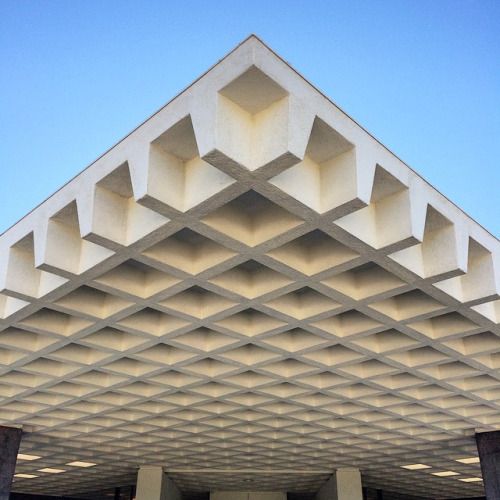
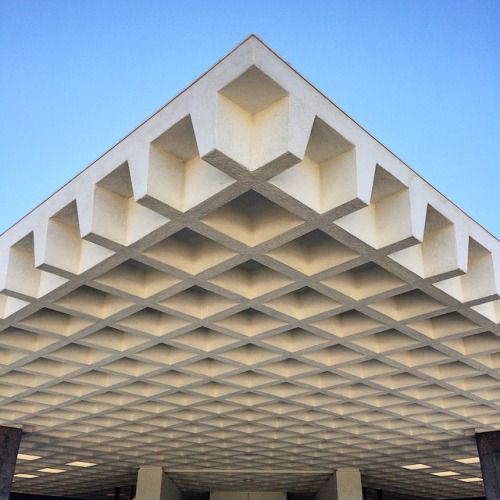
Larger spans can be built with coffered ceilings. However, construction costs may be higher compared to other types of ceilings because the concrete volume and formwork area are larger.
Rib plate
Rib plates are also somewhat similar to waffle plates. Generally the panels are supported by ribbed beams.
Ribbed panels are only constructed on special occasions as they are somewhat difficult to construct due to the nature of the structure. Formwork arrangement is much more difficult compared to other types of panels.
The rib support can be rectangular or conical in shape. The decision can be made based on aesthetic appearance. The width of the rib support can be about 75mm – 150mm. However, the depth and width of the beam can be selected depending on aesthetic and structural requirements.
Prestressed concrete slabs
Due to its productivity in construction, prestressed concrete slabs are the most popular types of slabs among other types of slabs. The design and construction of prestressed concrete slabs are slightly different from other slabs.
There are basically two types of prestressed concrete slabs.
- Insertion of empty tubes into the in situ concrete slab and prestressing after the concrete has hardened.
- Pour concrete slabs and protect them.
The advantages of prestressed concrete slabs include, among others, the following:
- The area of the plate can be compared to normal reinforced concrete plate.
- Increasing the board length does not result in increased costs.
- Fewer joists are cheaper to install and maintain floor height.
- Using prefabricated ceiling panels reduces construction time.
When designing prestressed concrete slabs, the following aspects are taken into consideration, among others.
- Generally, the weight of the plate is balanced by the upward pressure exerted by the tension cables. This happens in construction.
- Increasing the span requires a greater ceiling thickness compared to normal ceilings.
- Although post-tensioning is done, it is necessary to provide a certain amount of reinforcement to the slab to prevent cracking.
Prestressed panels
Prestressed panels are used in bridge and panel construction. Beams must be installed at regular intervals to support the prestressed panels.
These types of panels are more efficient components that significantly reduce construction time.
Regular sized slabs are shaped and placed on the regularly spaced beams. These beams can be reinforced concrete beams, precast beams or prestressed concrete beams.
Prefabricated Panel
The construction of precast slabs is similar to the construction of prestressed concrete slabs discussed previously.
In this method, we made reinforced concrete slabs and placed them on the beams at regular intervals.
Prefabricated slabs cannot be expanded like prestressed concrete or prefabricated slabs.
Cantilever plate
The most common type of panel used in buildings. There appears to be no building without cantilevers. Generally, the slab extends beyond the beam or column without any support on the opposite edge. The plate is called a cantilever plate.
With these types of plates, the load is transferred only in one direction and to one support point.
Sufficient reinforcement is very important for cantilever slabs. Please pay attention to the following.
- Structural reinforcements must be provided in the direction of the cantilever beams and fixed to the upper web.
- Sometimes bottom reinforcing grids are not provided for cantilever slabs because no structural reinforcement is required.
- However, it is recommended to provide soil reinforcement to improve the durability of the concrete. Especially in tropical climates, where the ambient temperature rises to around 30 – 34 °C, 0 C there is the possibility of plate cracking due to thermal expansion and contraction.
- Therefore, sufficient distribution reinforcements must be provided to avoid thermal cracks. It is recommended to place distribution reinforcements at a distance of at least 200 mm.
The article Cantilever plate construction For more information about designs you can also look here.
composite panel
Composite panels are mainly used in steel buildings. If we need a concrete floor in a steel building, composite panel construction is carried out.
Composite panel is fundamentally different from panel types such as reinforcing panels. Some of the special features are as follows.
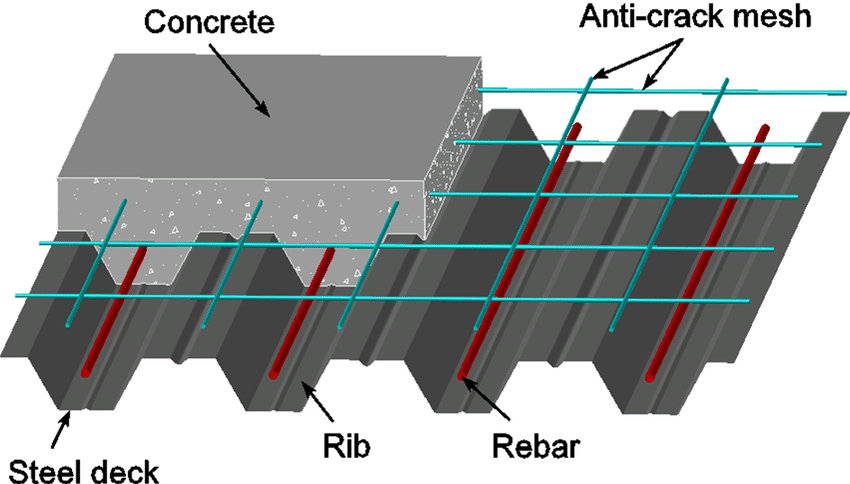
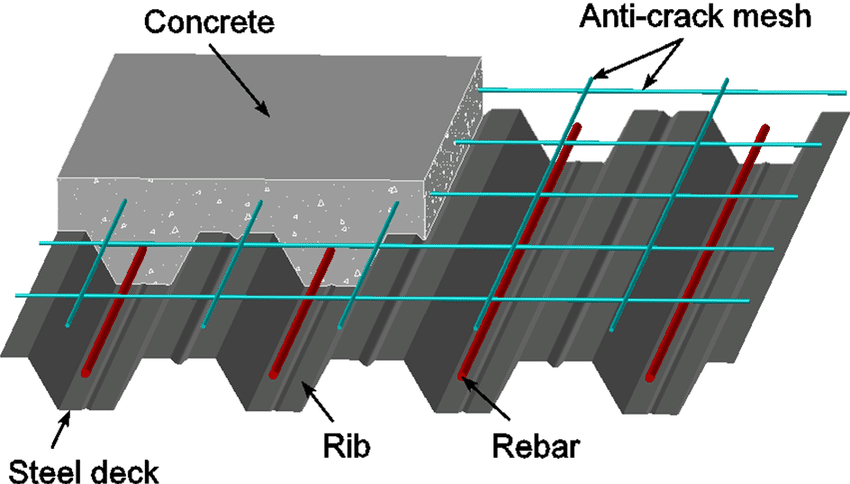
- The combined effect of concrete and steel supports loads
- Steel sheet formwork is also commonly used as formwork for concrete slabs. Where construction so requires, supports are used in concreting.
- Composite panels are stretched in one direction like disposable panels.
- The cover plate serves as bottom reinforcement. Lower reinforcement is applied where the construction requires it.
- In general, floor reinforcement is provided to improve fire resistance.
- Chip breakers and crack control reinforcement are provided.
- Shear bolts are provided to achieve beam bonding effect
Plate at ground level
Instead of hanging slabs, we built the slabs into the ground to support the ground floor. Although suspended slabs are heavily reinforced to support loads, this is not the case with ground-level slabs.
Generally, nominal reinforcement or BRC mesh is used. In special cases, we supply the reinforcement according to the project requirements. The construction of slab foundations is a good example of this.
If we support the strong structure, thicker concrete is provided for reinforcement like a normal slab.
Umbrellas
Sunshades are sometimes called canopy panels. They are installed around doors and windows to block sunlight and prevent rainwater from entering through windows.
Parasols are less reinforced concrete elements. Reinforcing the umbrellas is safer and improves the durability of the concrete.
Kitchen tops
Kitchen tops are sometimes called countertops. They are not only used in kitchens, bathrooms, pantries and many other places.
The panel thickness is between 50 and 100 mm, depending on the support and space required.
Most often BRC networks or single reinforcement networks are used.
Cable Suspension Plate
These are the plates on which the overhead cables are stored. They are on suspension bridges.
The panel is supported by a steel structure suspended by high-strength cables. These bridges are not common and are built on special occasions when we can have more support than other bridges.
Suspension bridge that mainly crosses rivers.
Pitched Roof Panels
The use of reinforced concrete slabs to cover buildings is not common and is new in construction. There are old and new structures.
However, constructing pitched roof panels is challenging due to the nature of the structure. Pouring concrete in an inclined direction and working there is a little difficult. Additionally, tying the reinforcement is also a challenge.
It is common to use concrete with low sinkability for Concrete In addition, greater attention must be paid to thermal cracking of concrete.
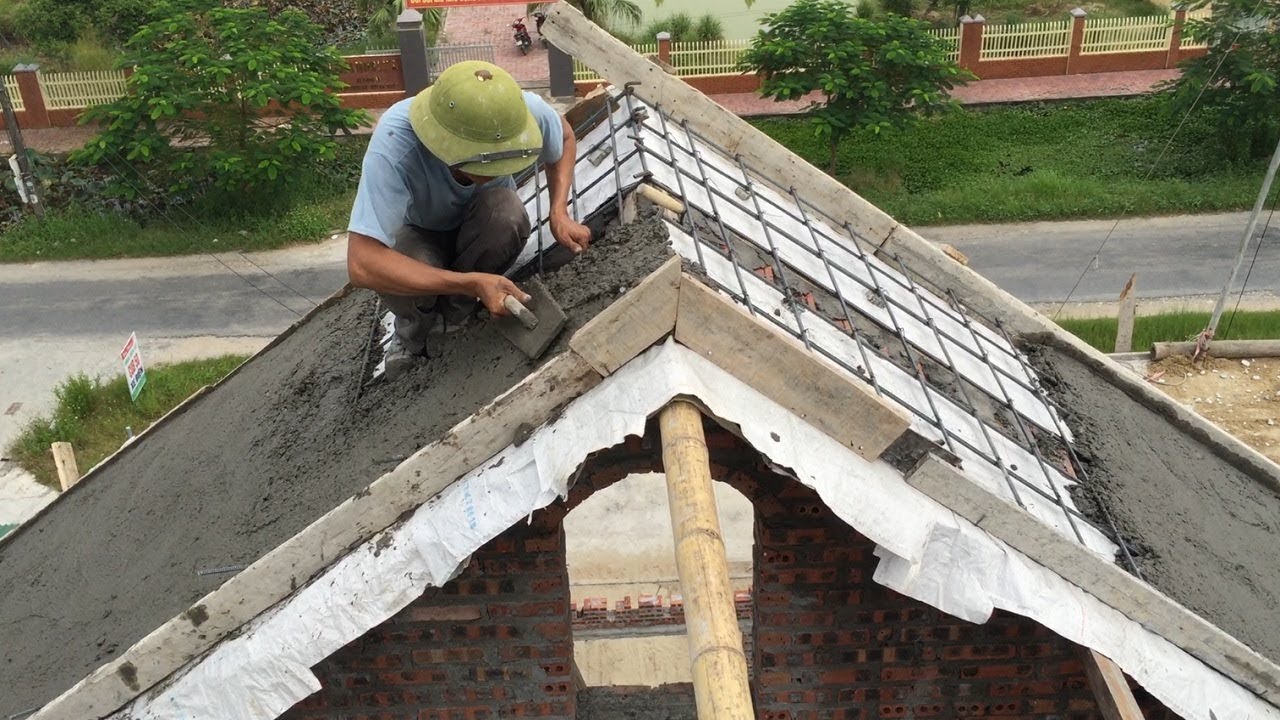
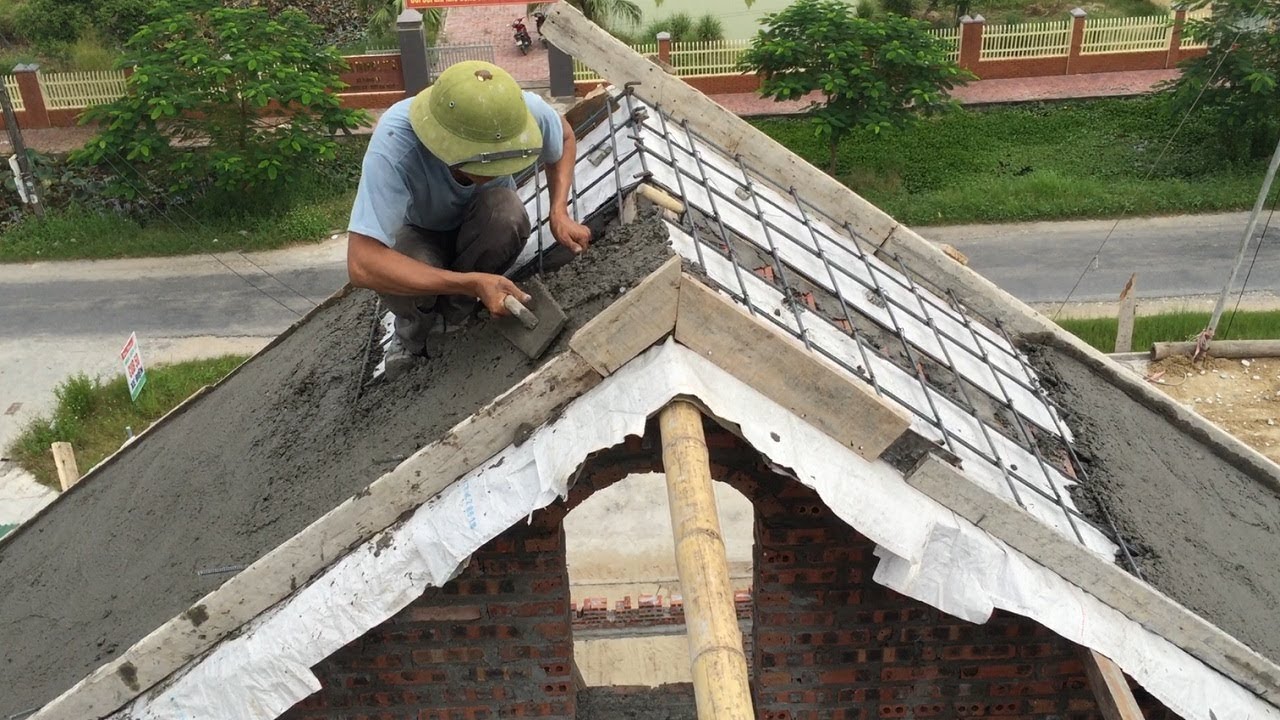
To prevent water from entering through the roof, if it is not additionally covered with membranes, sufficient reinforcement is required to prevent cracks in the raw concrete and during use. In addition, attention must be paid to the hardening of the concrete.
Dome Plates
Dome plates are very special types of plates, the design and construction of which represent a great challenge.
They are mainly installed in structures where the aesthetic aspect of the dome is important and in religious places.
The nature of the structure makes construction difficult. The curved shape complicates the execution process. Computer assistance software is mainly used to design the dome structures.
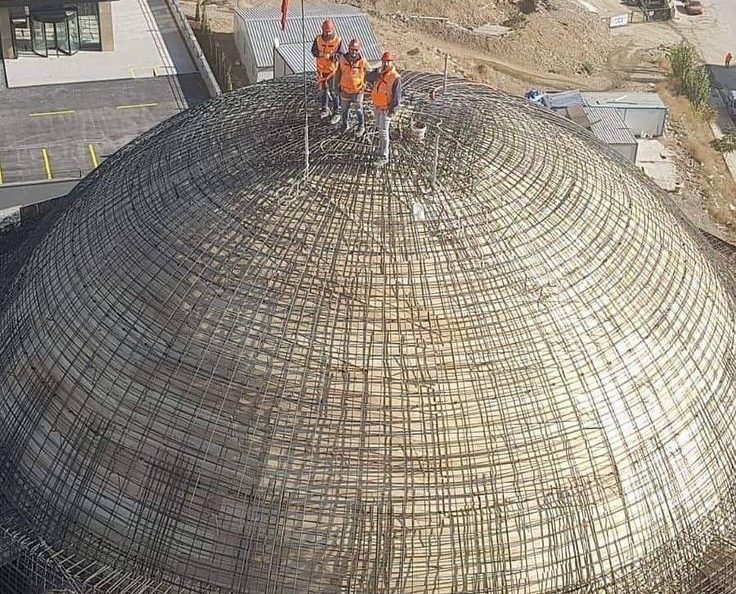
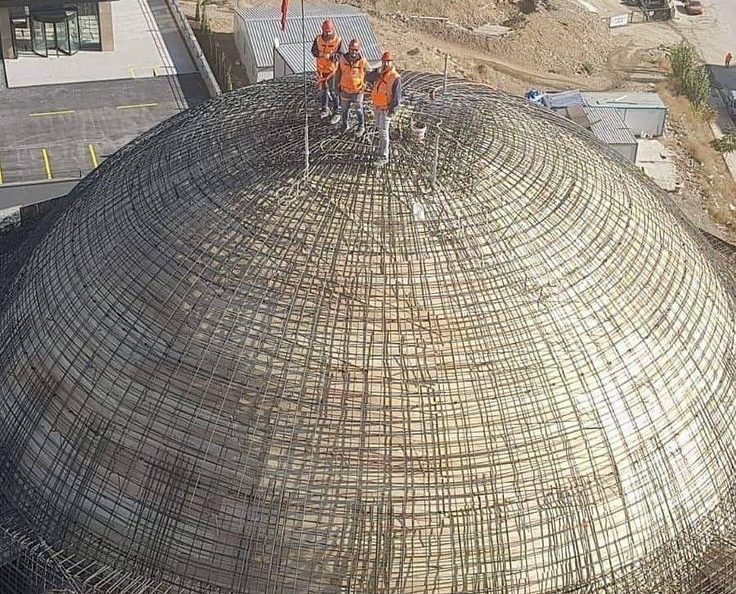
Bubble Cover Plate
Pouring a large amount of concrete results in very high costs. Furthermore, the most effective area of the concrete is close to the outermost fibers of the section.
This means that the concrete in the central part of the section does not contribute much to the absorption of bending moments. It must withstand shear forces and maintain the connection of the upper and lower parts.
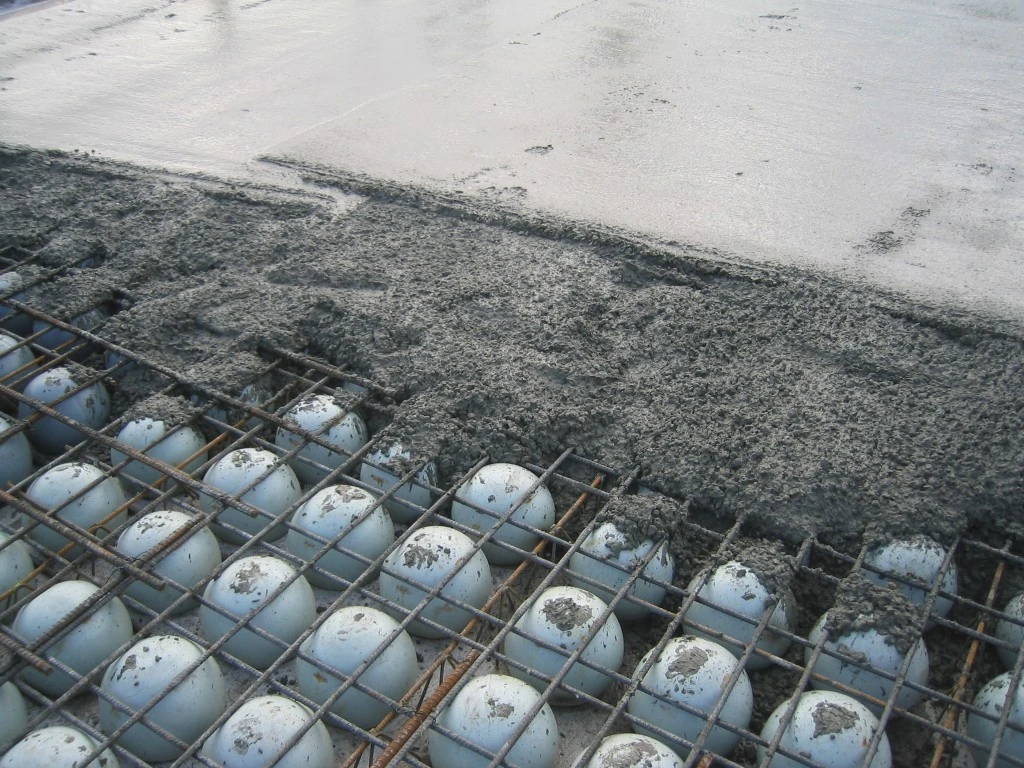
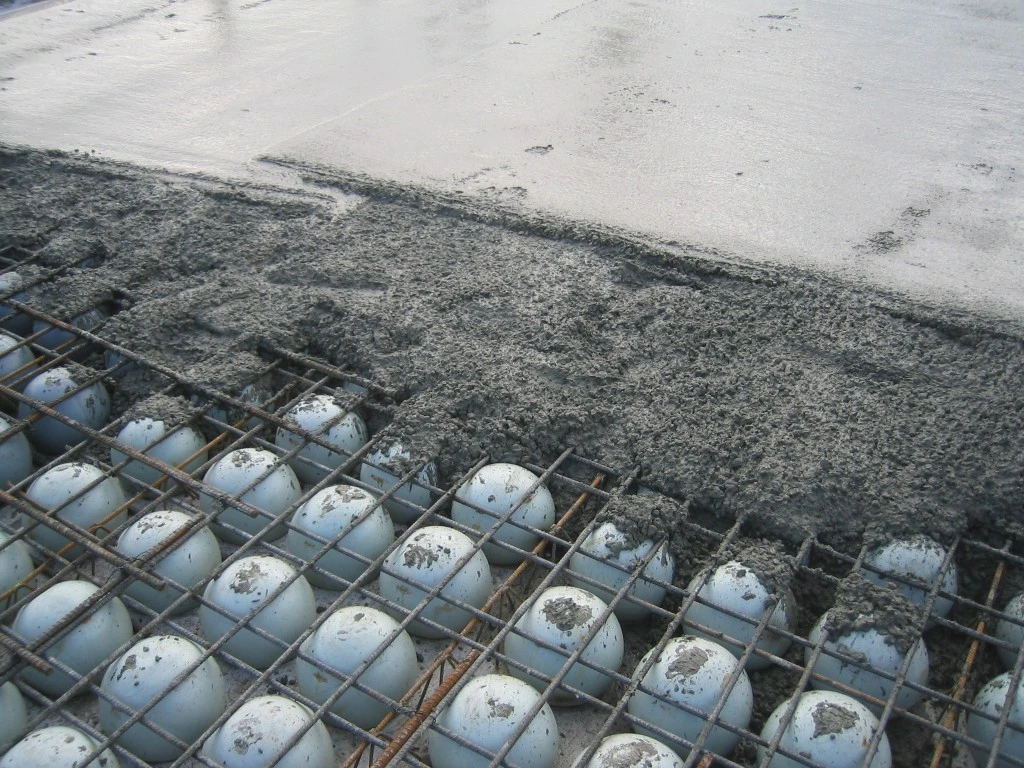
A cavity is created inside the plate and construction is carried out accordingly. Building bubble deck panels is somewhat challenging due to the difficulty of creating voids in the concrete. However, there are methods to do this.
Hollow Body Ceiling
Hollow panels are also a type of panel similar to studded ceiling panels.
Instead of the bubbles, a through hole is created in the plate section. This type of panels is used in the construction of bridge decks.
Removable flexible material or permanent formwork is used for construction.
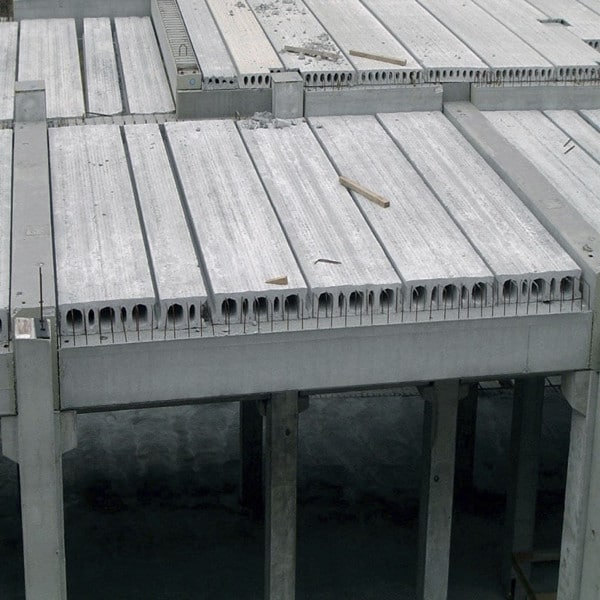
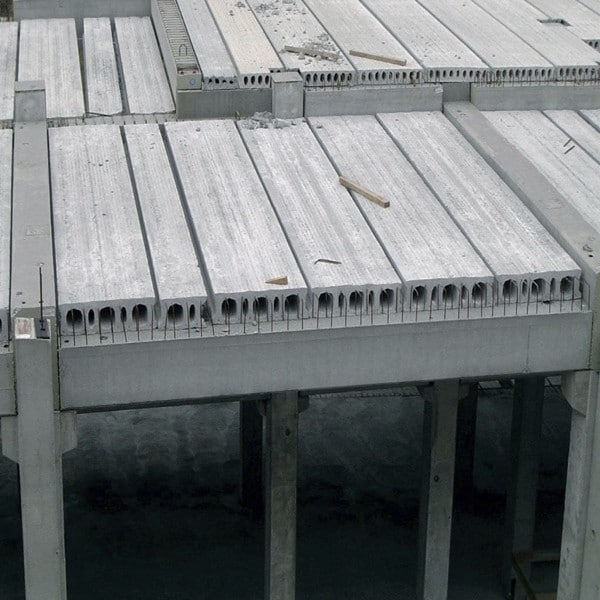
Hardy Record
Hardy panel construction is carried out as prefabricated construction or as in situ concrete construction.
In simple terms, sturdy slab construction is the construction of slabs of prefabricated blocks that rest on beams placed at regular intervals. It can be described as follows.
- First, the blocks are constructed. The block length is in the range of 450 mm. This may vary depending on the design.
- These blocks are generally hollow blocks.
- One method is to place prefabricated or post-tensioned beams, place the blocks on top and apply a layer of concrete with BRC mesh.
- Another option is to build the cast-in-place concrete beams, place the blocks and place the concrete fill with BRC mesh.
- This is a very quick and sometimes economical construction method.
Sunken plate
As the name suggests, it is a type of slab that is built by lowering the top level of the slab in relation to the other slabs. Furthermore, building another slab under the original slab to hide the utilities is also known as a sunken slab.
Recessed panels are installed in sanitary areas, balconies, patios, etc.
The detailing of the slab reinforcement must be done accordingly.
Related articles on board types
- Plate reinforcement details
- Difference Between Disposable Dishes and Two-Way Dishes
- Cantilever plate construction
- Plate deflection
- Panel construction to BS 8110
- Panel placement methods
- Board thickness
- Deflection of beams and slabs

